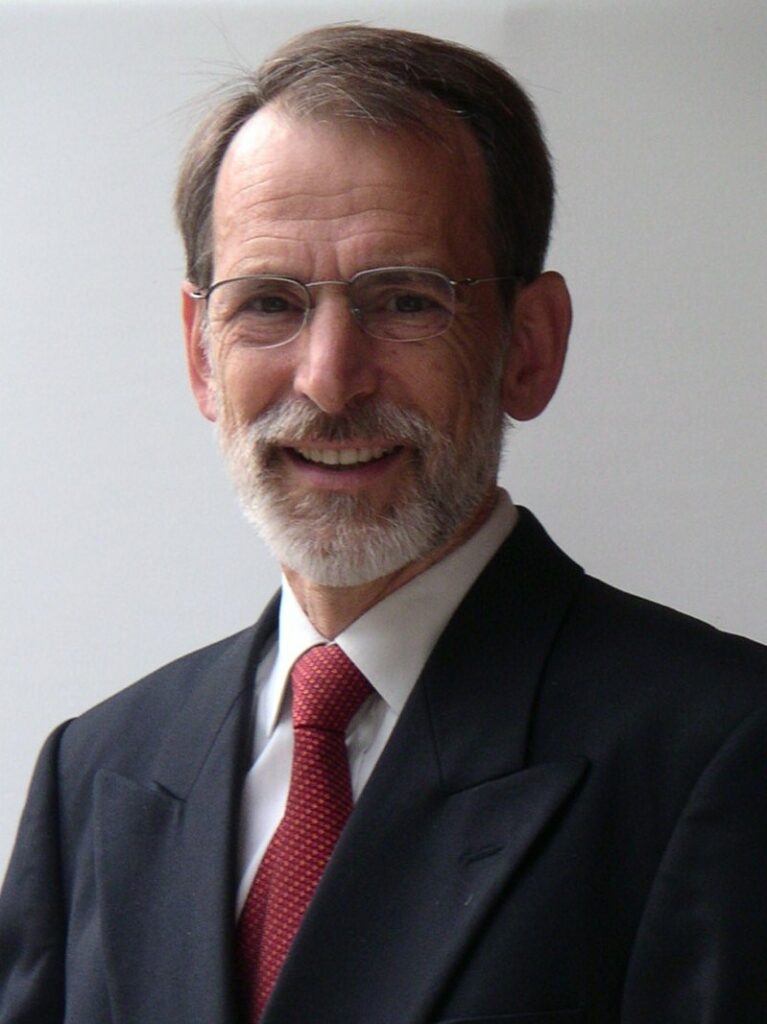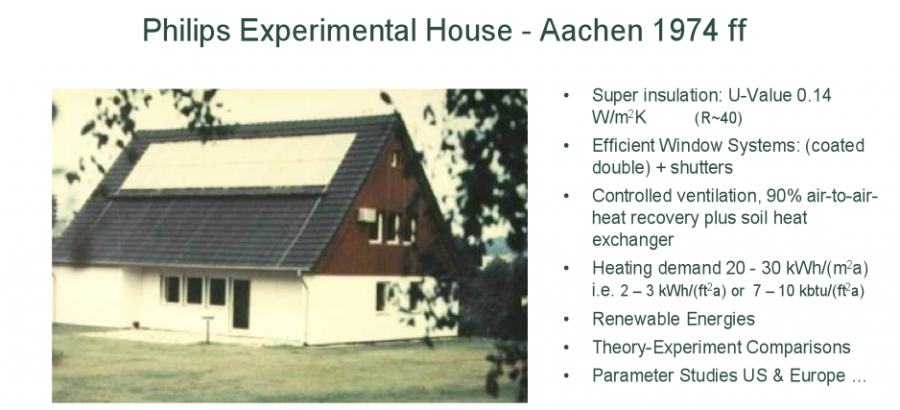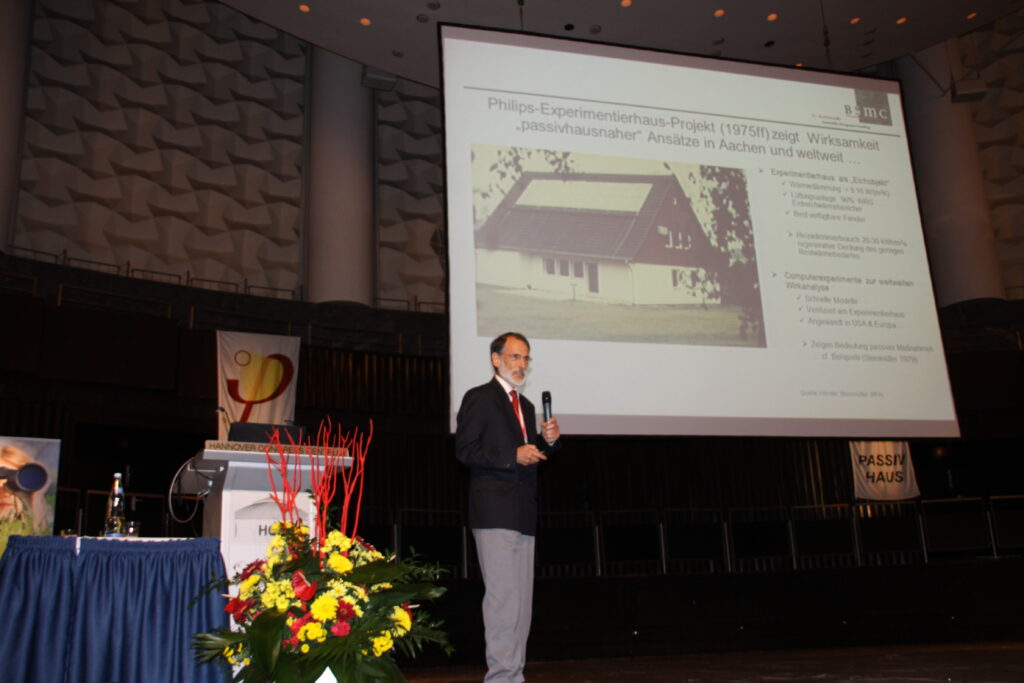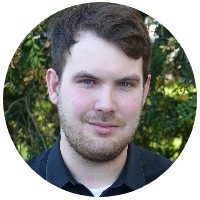
In 2012, Dr. Bernd Steinmüller, together with the other members of the project team responsible for the systematic study of energy-efficient buildings (namely Dr. Horst Hörster, Dr. Günther Bergmann, Dr. Richard Bruno, Dr. Wilhelm Hermann, Dr. Reinhard Kersten, and Ing. Klaus Klinkenberg), received the Passive House Pioneer Award.
The systematic study began with the Philips Experimental House in the mid-seventies. The building, constructed in the German city of Aachen, was equipped with excellent thermal insulation, a controlled ventilation system, a ground heat exchanger, as well as solar and heat pump technology. The building was “occupied” by a computer which simulated occupant behaviour and provided important monitoring results. The physical building itself was necessary to evaluate new equipment, collect detailed experimental data and prove the validity of the computer modelling and simulations, which were then used to investigate the potential of active and passive measures in buildings in a variety of climates. It was demonstrated that the implementation of passive measures alone could account for a heating energy savings factor of 10 to 20 compared to the building standards of the time. The lessons learned from this project and subsequent work by Dr. Bernd Steinmüller have played an integral role in the development of the Passive House standard.
We had the opportunity to talk with Dr. Bernd Steinmüller, who recently became a Passive House Building Certifier, about his work on the modelling and simulations portion of the Philips Experimental House project and his continued work in the field today. Here is what he had to say:
What is your impression of the Pioneer Award? Do you remember your first thoughts upon learning you were to be a recipient?
When I learnt that it was supposed to only be me who would receive the award, I called back and suggested that it should not be just me, but the Philips Research Team as a whole who should be honoured. Of course, I was happy that the work I had done on the modelling and systematic parameter studies has finally received so much attention and had helped to inspire the Passive House work of today…
I didn’t realise that it was your idea to have the rest of the team included as part of the award. Obviously a project as large as this one is a group effort. Having worked primarily on the modelling and simulation portion of the project, what do you recall were some of the biggest challenges you had to overcome?
I entered the field as a theoretical physicist who had investigated relativistic stars but never buildings. Thus, the first challenge was to get a clear understanding of the system weather, building equipment, occupants, occupant behaviour and building operation. I and my colleagues – where I especially want to give credit to my first mentor Dr. Richard Bruno – also needed to identify the main system parameters and mathematical descriptions that on the one hand side were sufficiently elaborate to adequately describe all the aspects relevant to the task at hand and, on the other side, sufficiently simple to allow a great number of year-round calculations in various locations of the world.
Remember, computer power was extremely limited at that time, while fast verified computer models and even representative year-round reliable hourly weather data were scarce or missing. Thus, a lot of “ground work” was necessary, not only to establish verified fast computer-models, but also suitable weather and building databases to execute thousands of virtual computer experiments and evaluate them in a consistent, comprehensible way.
How many hours of simulations do you think went into this project?
To my estimate some 10,000 hours computing time….
What motivated you to take on such an ambitious project to begin with?
After having dreamt of becoming an architect (like my grandfather), I wanted to understand the fundamentals of nature, studied physics, philosophy, scientific theory, relativistic astrophysics and ended up working in the computer modelling of collapsing stars and completing a thesis about wave propagation from pulsating neutron stars (1969-75). At the same time the “oil crisis” (1973), Meadows fundamental computer studies on “limits to growth” (1972) and constructive philosophy made me deeply aware of the importance of the practical application of theoretical insight/mathematics/ physics/computer science to “real problems”. Thus, when I heard about the new project at Philips Research in Aachen on “rational use of energy and solar energy in buildings” (later often referred to as the “Philips Experimental House Project”) it seemed to me as a great challenge ideally suited to my background, targets and personal ambitions.

What was the initial feedback like from Philips Research when the project team came to them with the results? The original intention of the study was to demonstrate the feasibility of alternative energy sources for active measures related to energy, correct?
Philips was greatly interested in the project right from the beginning because, after the oil crisis 1973, it addressed questions of key importance to industry and society as a whole. Thereby “positive” results, which could lead to new industrial products, were of particular interest. However “negative” results which showed the limits of certain technologies were almost as valuable, because they helped to understand the general settings and avoid unfavourable investments. “Positive” results were shown in the form of prototype evacuated solar collectors installed on the roof of the Philips Experimental house. Moreover, the potential of small heat pump applications, heat-pipe based heat exchangers, solar roofs, sensible as well as latent heat storage were demonstrated. Yet our computer-based simulations with European and American weather data showed the relatively limited effects these measures would have in comparison to pure “passive” measures applied to the building envelope. Thus – for a company which had set out to look for business opportunities on the active side – the paradoxical result was that passive measures should receive top priorities first of all.
Do you remember the external feedback (from scientists, building physicists, etc.) you received?
As the project addressed key energy questions in a very broad, fundamental way with solar energy being a part of it, it received very high interest not only within Philips, but also in the public and scientific community in and outside of Europe. Thereby public expectations were strongly driven by a “solar hype and hope”, which the Philips research team did not satisfy in the way many people were hoping We even had to warn of so-called “passive-solar” buildings with extensive glazing, which could be feasible in more sunny climates – but would not be a good option under mid- and north-European weather conditions.
On the other hand, the “passive” measures that we found most promising were met with resistance in the conventional building industry. This resistance was backed by scepticism among traditional building scientists often sponsored by these industries. Amongst them, there was a focus on traditional heavy constructions, the dynamic behaviour of single walls and single rooms during single heating and cooling design days and an overestimation of short-term capacitive effects so that “massive” instead of year-round effective optimised “passive” solutions were propagated.
The German ministry of research, which had funded our project considerably, tried to take a neutral position, but eventually – in spite of my/our warnings – it succumbed to the “massive-passive solar hype” and – with the support of the Fraunhofer Institute of Building Physics – started the solar Landstuhl-Project which – as expected –ended up having extremely high energy consumption levels. Unfortunately, these levels were then used as the calibration and starting point for further scientific progress and national standards in many subsequent publications.
You have remained very involved in the Passive House movement. How do you think the Passive House buildings of today compare with the buildings you examined in detail as part of the project (e.g. the Philips Experimental House and the so-called “Swedish” and “Normal” houses)?
Today, there exist a huge number and great variety of “real” Passive House buildings, old and new and in many architectural styles, different climates and for different user behaviour patterns. This proves the wide applicability of the Passive House Standard.
After the oil crisis of 1973 there were no Passive Houses at all. The standard house in Germany reflected the heat protection standard DIN 4108 as defined in 1969. It was characterised by single-glazed-windows (U-Value 5.9), poorly-insulated walls (U-value 1.6), high air infiltration rates and ventilation losses (annual average ca. 1.5 h-1) leading to heating demands a factor of 10 to 20 above that of current Passive Houses. The most progressive standards were found in Sweden (SBN 1975) with double-glazed windows (U-Value 2.3) and well-insulated walls (U-Value 0.3), improved air-tightness and controlled ventilation (annual average 0.5 h-1). This reduced the heating demand by a factor of 3 to 4. The Philips Experimental House was derived from a conventional prefabricated wooden-frame house equipped with the best windows available at that time (U-Value 1.3 with or 1.9 without shutters), additional insulation in the walls (U-Value 0.16), controlled ventilation with heat recovery and an earth heat exchanger thereby reducing the heating demand by a factor of 10 to 20.
In short: the Experimental House displayed the main features of a modern Passive House – except for the windows, which at that time were not available on the market; rather, they existed solely as research prototypes in our lab or virtual models on the computer.

I see that you now own your own company – Dr. Bernd Steinmüller Sustainability Management Consulting (BSMC) – and since the Philips Experimental House, you have been involved in a number of projects related not just to energy efficient building, but also sustainability as a whole. Care to share with us some of the things you have worked on over the years?
After my time with Philips Research Aachen (1977 – 83) I moved into the development of software systems for the computer-aided design of very large scale integrated microelectronic systems at central Philips Research Eindhoven. In 1985, I was appointed to build up and direct a newly founded joint R&D-Institute in the areas of CAD-Electronics, Computer-Aided Concurrent Engineering, CAx-Frameworks, European and international standardisation.
In the digital sector, innovation cycles were counted in just fractions of a year – as opposed to decades in the building sector. Hence, when I returned to building science in 1997 as member of the Managing Board and Director Energy at the “Institute for Housing and the Environment IWU”, it appeared that the conventional building world had moved very slowly – although the Passive House innovation was at hand, the climate problem had already become apparent. As it had become clear that old buildings required special attention, I – together with other pioneers – promoted sustainable dwelling and Passive House techniques in old buildings, thereby initiating and organising a series of workshops, talks, publications as well as a state competition on sustainable refurbishment.
In 2001, I founded „Dr. Bernd Steinmüller Sustainability Management Consulting BSMC“ in Paderborn and engaged in interdisciplinary consulting for politics and business organisations with a continued focus on energy and buildings. In addition, I acquired an MBA in “sustainability management”, founded a network for sustainability consulting and worked on corresponding standardisation and advisory boards. My most recent projects have been “family” ones, refurbishing old houses into EnerPHit and Passive House Plus buildings. Currently, climate change is my main concern internationally, nationally and locally. Apart from speaking at international events, I attempt to push German standards towards Passive House. In my home town of Paderborn, which introduced the Passive House Standard to new buildings some eight years ago, I am engaged in making sure that these standards are also respected in retrofitting projects.
You will also be speaking at the upcoming International Passive House Conference in China. Can you tell us briefly what you will be discussing there?
In my talk “From Experimental to Passive House Plus: Some 4-Decades Worth of Insights” I plan to outline the development from early Experimental to latest Passive Plus Houses. Illustrated with examples from my own professional environment, I will discuss driving and hindering forces and will show that the set of progressive Passive House Standards provides an excellent framework for deriving sustainable solutions for new as well as old buildings. In order to finally achieve the urgently needed broad break-through, corresponding political support with strong sustainable building codes reflecting the Passive House Standard, the broad education of decision makers, architects, planners and craftsmen is needed. The conference in China, held at a site where the world’s largest Passive House settlement is built, can and must act as an important eye-opener and catalyst for change.
Further reading
Philips Experimental House Research 1974ff: Passive versus Active Measures in Europe & America
The Limits to Growth: A report for the Club of Rome’s Project on the Predicament of Mankind






 Carl supports our international communication activities and is the point of contact for administrative enquiries.
Carl supports our international communication activities and is the point of contact for administrative enquiries.
Interesting interview. Thanks for moving the world wide housing industry forward the Passivhaus! Great and professional Dr. Bernd Steinmüller!!